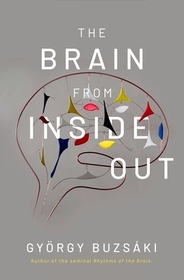
The Brain from Inside Out
-
10% KEDVEZMÉNY?
- A kedvezmény csak az 'Értesítés a kedvenc témákról' hírlevelünk címzettjeinek rendeléseire érvényes.
- Kiadói listaár GBP 64.00
-
30 576 Ft (29 120 Ft + 5% áfa)
Az ár azért becsült, mert a rendelés pillanatában nem lehet pontosan tudni, hogy a beérkezéskor milyen lesz a forint árfolyama az adott termék eredeti devizájához képest. Ha a forint romlana, kissé többet, ha javulna, kissé kevesebbet kell majd fizetnie.
- Kedvezmény(ek) 10% (cc. 3 058 Ft off)
- Kedvezményes ár 27 518 Ft (26 208 Ft + 5% áfa)
Iratkozzon fel most és részesüljön kedvezőbb árainkból!
Feliratkozom
30 576 Ft

Beszerezhetőség
Becsült beszerzési idő: A Prosperónál jelenleg nincsen raktáron, de a kiadónál igen. Beszerzés kb. 3-5 hét..
A Prosperónál jelenleg nincsen raktáron.
Why don't you give exact delivery time?
A beszerzés időigényét az eddigi tapasztalatokra alapozva adjuk meg. Azért becsült, mert a terméket külföldről hozzuk be, így a kiadó kiszolgálásának pillanatnyi gyorsaságától is függ. A megadottnál gyorsabb és lassabb szállítás is elképzelhető, de mindent megteszünk, hogy Ön a lehető leghamarabb jusson hozzá a termékhez.
A termék adatai:
- Kiadó OUP USA
- Megjelenés dátuma 2019. július 11.
- ISBN 9780190905385
- Kötéstípus Keménykötés
- Terjedelem464 oldal
- Méret 160x239x33 mm
- Súly 794 g
- Nyelv angol
- Illusztrációk György Buzsáki's The Brain from Inside Out examines why the outside-in framework for understanding brain function have become stagnant and points to new directions for understanding neural function. Building upon the success of Rhythms of the Brain, Profe 800
Kategóriák
Rövid leírás:
György Buzsáki's The Brain from Inside Out examines why the outside-in framework for understanding brain function have become stagnant and points to new directions for understanding neural function. Building upon the success of Rhythms of the Brain, Professor Buzsáki presents the brain as a foretelling device that interacts with its environment through action and the examination of action's consequence. Consider that our brains are initially filled with nonsense patterns, all of which are gibberish until grounded by action-based interactions. By matching these nonsense "words" to the outcomes of action, they acquire meaning. Once its circuits are "calibrated" by action and experience, the brain can disengage from its sensors and actuators, and examine "what happens if" scenarios by peeking into its own computation, a process that we refer to as cognition.
TöbbHosszú leírás:
Is there a right way to study how the brain works? Following the empiricist's tradition, the most common approach involves the study of neural reactions to stimuli presented by an experimenter. This 'outside-in' method fueled a generation of brain research and now must confront hidden assumptions about causation and concepts that may not hold neatly for systems that act and react.
György Buzsáki's The Brain from Inside Out examines why the outside-in framework for understanding brain function has become stagnant and points to new directions for understanding neural function. Building upon the success of 2011's Rhythms of the Brain, Professor Buzsáki presents the brain as a foretelling device that interacts with its environment through action and the examination of action's consequence. Consider that our brains are initially filled with nonsense patterns, all of which are gibberish until grounded by action-based interactions. By matching these nonsense "words" to the outcomes of action, they acquire meaning. Once its circuits are "calibrated" by action and experience, the brain can disengage from its sensors and actuators, and examine "what happens if" scenarios by peeking into its own computation, a process that we refer to as cognition.
The Brain from Inside Out explains why our brain is not an information-absorbing coding device, as it is often portrayed, but a venture-seeking explorer constantly controlling the body to test hypotheses. Our brain does not process information: it creates it.
The Brain from Inside Out is an impressive display of erudition, rounded off with just the right amount of storytelling and autobiographical notes.
Tartalomjegyzék:
Preface
Chapter 1: The Problem
Chapter 2: Causation and Logic in Neuroscience
Chapter 3: Perception from Action
Chapter 4: Neuronal Assembly: The Fundamental Unit of Communication
Chapter 5: Internalization of Experience: Cognition from Action
Chapter 6: Brain Rhythms Provide a Framework for Neural Syntax
Chapter 7: Internally Organized Cell-Assembly Trajectories
Chapter 8: Internally Organized Activity During Off-Line Brain States
Chapter 9: Enhancing Brain Performance by Externalizing Thought
Chapter 10: Space and Time in the Brain
Chapter 11: Gain and Abstraction
Chapter 12: Everything is a Relationship: The Non-Egalitarian, Log-Scaled Brain
Chapter 13: The Brain's Best Guess
Chapter 14: Epilogue
Index











